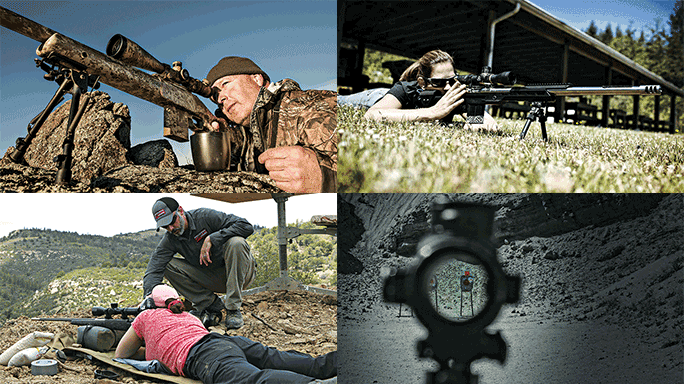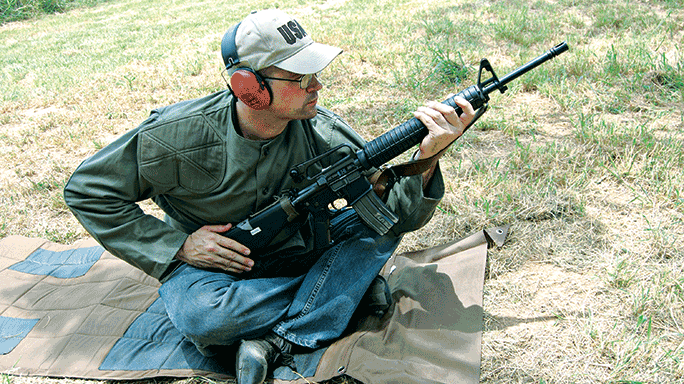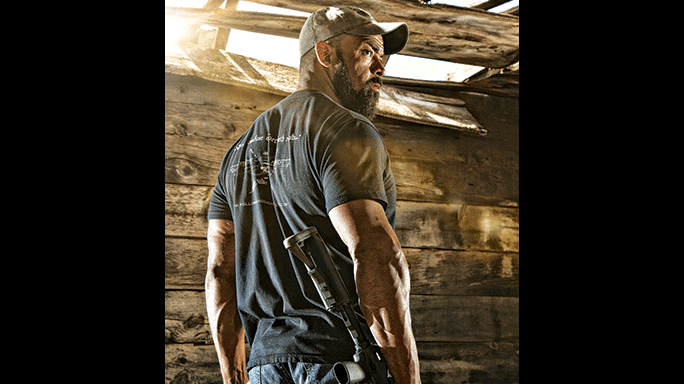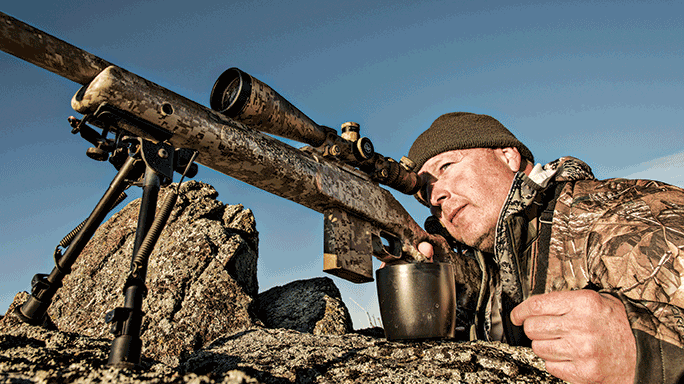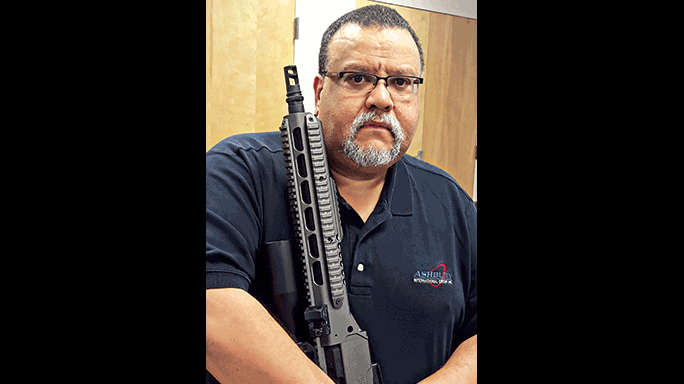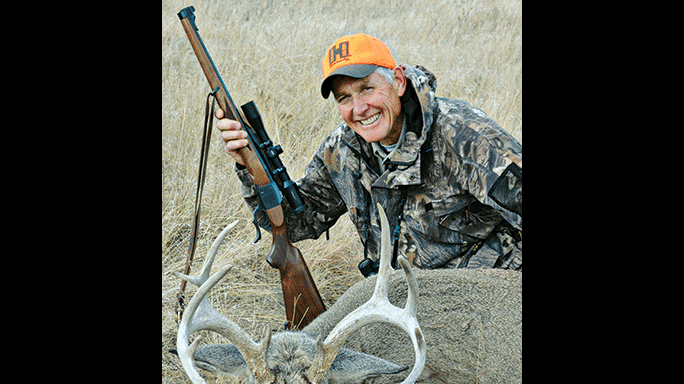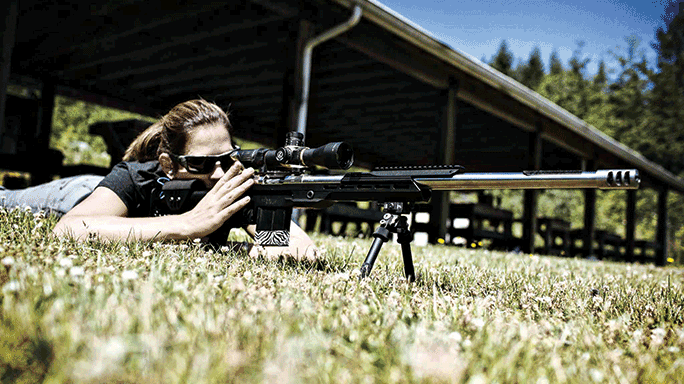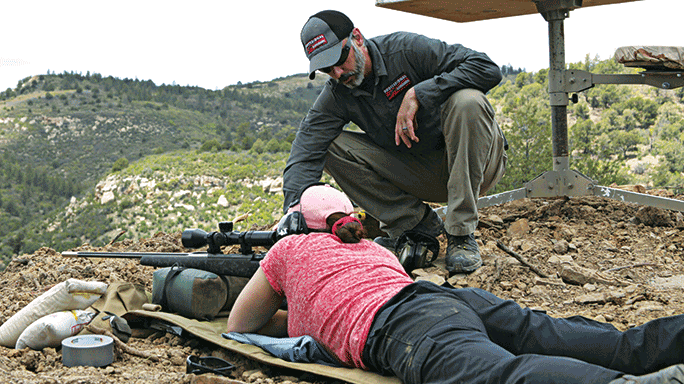Compiled by John Scott & John Naderi
You hear it all the time—at shooting ranges, at gun shops. You even read about it in online forums. What is the “best” caliber for precision shooting? This question fuels a topic truly worthy of a debate that’s no doubt been raging since the invention of the rifled barrel. It’s a worthy question for sure, but what seems like a straightforward query isn’t actually as simple as it seems. To get a precise answer, one must filter the question down to the individual shooter and his or her needs.
- RELATED STORY: 18 Experts Pick Their Concealed Carry Weapon of Choice
Many factors affect your choice of calibers, including the intended use, shooting platform, shooting location and distance, and what is considered a precise shot, to name just a few. Some may consider a precise shot a fraction of a minute of angle (MOA), while others believe that if you can take down a moving target at an extended distance, that’s all the precision that matters. For this installment of Ballistic’s Round Table, we’ve asked industry insiders and expert shooters, “What is your preferred caliber for precision shooting at distances of 500 to 1,000 yards and beyond?”
Advertisement — Continue Reading Below
- RELATED STORY: 8 Experts Pick Their Home Defense Weapon of Choice
You’ll hear from military marksmen, competitive shooters, hunters and more, and get an insight that can only be gleaned through personal experience. Our diverse panel of Round Table experts is meant to stoke debate and provoke thought and further research. Perhaps the panel members’ answers will reinforce your support for a particular caliber, or maybe they will open your mind to another choice. Read on to learn exactly what our panel said.
JOHN BUOL
- Affiliation: U.S. Army Reserve Marksmanship Program, Firearm User Network
- Position: Sergeant first class, instructor
- Preferred Caliber For 500 To 1,000 Yards And Beyond: 5.56mm NATO
- Preferred Rifle And Optic: See below
Why? I know it’s an odd choice, so let me explain. Soldiers don’t get to shoot their “preferred” caliber or cartridge—they have to use what they’re issued. From 2003 to 2009, I was mobilized full-time to conduct small-arms training for over 30,000 deploying personnel, and they all used what Uncle Sam provided. Military marksmanship teams do likewise. Combat matches use unmodified gear, and precision-oriented conventional matches such as those at Camp Perry allow modifications. This tests the maximum capabilities of human performance with as-issued and tweaked gear.
Advertisement — Continue Reading Below
Even if personal preference was an option, very few military-trained personnel have the skill to exploit it. Combat matches routinely go out to at least 500 meters, and good-enough shooting for “expert” Marine qualification might still be sloppy enough to lose 80 percent of the available points in a match. The 5.56mm and AR-15 dominate Service Rifle, even against M14s shooting .308 Winchester rounds at 600 yards. It can hit when handled well.
Yes, there are cartridges more suited to long-range shooting, but too many shooters are too quick to ignore skill. Qualifying on a sniper or designated marksman course with a precision sniper rifle is often routine for even novice marksmen, as the standard is much lower than most competitive courses. Demonstrating ability with more basic equipment forces you to improve your skills. A skilled shooter benefits from improved equipment much better than a novice more concerned with gear than personal ability.
Try shooting at long ranges with the 5.56mm NATO/.223 Remington. Basic issued equipment with ball ammunition is more capable than many people have the skill to realize.
Advertisement — Continue Reading Below
BUCK DOYLE
- Affiliation: Follow Through Consulting, retired USMC
- Position: CEO and owner, firearms instructor
- Preferred Caliber For 500 To 1,000 Yards And Beyond: .260 Remington (130-grain Berger AR Hybrid OTM Tactical)
- Preferred Rifle And Optic: AR with a 16- or 18-inch barrel with a 1-in-7-inch twist rate, along with a variable-power scope utilizing a first-focal-plane Horus Tremor2 or Tremor3 reticle
Why? During my uniformed days, I relied on the 175-grain Sierra HPBT bullet (M118LR) for precision fire within the 500- to 1,000-meter range. With that said, in a perfect world, the 130-grain .260 Remington Berger AR Hybrid OTM would be my first choice.
This particular bullet maximizes the capability of the AR platform, providing an optimal ballistic coefficient and retaining plenty of velocity at extended ranges out to 1,500 meters. You can top this off by throwing on a good piece of glass (containing the Tremor2 or Tremor3 reticle) and using a Kestrel with Applied Ballistics software.
Advertisement — Continue Reading Below
GEORGE HAWTHORN
- Affiliation: Kimber America
- Position: Rifle engineer
- Preferred Caliber For 500 To 1,000 Yards And Beyond: 6.5 Creedmoor
- Preferred Rifle And Optic: Kimber Advanced Tactical SOC and Vortex Viper PST 6-24x50mm FFP scope with EBR-2C MRAD reticle
Why? The .308 Winchester is probably my all-time favorite cartridge, but if you want to be competitive at paper-punching or ringing unknown-distance steel targets out beyond 1,000 yards, the low-recoiling 6.5mm cartridges are a great choice. Comparing the ballistics of Federal’s 175-grain .308 Winchester Gold Medal Match to Hornady’s 140-grain 6.5 Creedmoor A-MAX shows that the Creedmoor has 25-percent less wind drift at all ranges and close to 20-percent less drop at 1,000 yards. Ballistic tables are easy to generate with any number of calculators, but those tables are only as good as the inputs from the shooter/spotter. A 2-mph error in wind speed estimation at 1,000 yards equates to approximately 0.5 MOA more error on target for the .308 Winchester compared to the 6.5 Creedmoor. The 6.5 Creedmoor is an easy cartridge to load, with excellent match and hunting bullets available, and the shorter case offers some advantages over the venerable .260 Remington cartridge.
Kimber’s Advanced Tactical SOC in 6.5 Creedmoor offers an adjustable folding-stock chassis that accepts detachable AI-style magazines. Other features include controlled round feeding, an excellent single-stage adjustable trigger, a three-position firing pin safety that allows the bolt to be locked and one of the best production barrels in the industry. Accuracy testing with Hornady ammunition at 100 yards typically results in five-shot groups in the 0.2- and 0.3-inch range.
Advertisement — Continue Reading Below
I own scopes from Leupold, Nightforce, Zeiss and Premier Reticles, but in the last year have discovered Vortex Optics products. I use front-focal-plane mil optics for long-range shooting, and there probably isn’t a better choice for the money than the feature-packed Vortex Viper PST 6-24x50mm FFP. The glass is very good and the adjustments are repeatable, which is essential if you regularly dial in elevation and windage corrections. If money were no object, I’d opt for one of the Razor models.
MORRIS PETERSON
- Affiliation: Ashbury Precision Ordnance
- Position: President and CEO
- Preferred Caliber For 500 To 1,000 Yards And Beyond: Currently our recreational-shooting clients and tactical competitors are very committed to the 6.5 Creedmoor caliber, strongly favoring Hornady’s 140-grain A-MAX ammunition. Beyond 1,000 yards in the extreme and ultra-long-range arena, the .338 Lapua Magnum and .375 CheyTac super magnums are overwhelming favorites. The .338 Lapua is a real thumper with 300-grain RUAG Swiss-P target ammo, and the .375 CheyTac is an absolute hammer with 350-grain Sierra MatchKing and 350- and 375-grain RMB-ULD projectiles launched around 3,050 fps. We’re seeing 1 mile as the new ultra-long-range rifle marksmanship threshold.
- Preferred Rifle And Optic: As you might guess, I am a bit biased toward APO precision rifles, with my favorite being our new SPR (SABER Precision Rifle) in 6.5 Creedmoor with a V17 Alloy Series M-LOK forend. Our clients are strongly favoring the Leupold brand; more specifically, the Mark 8 3.5-25x56mm M5B2 scope with the illuminated H59 reticle followed by the Mil-Dot reticle.
Why? The 6.5 Creedmoor SPR weighs around 13 pounds kitted out and provides consistent sub-0.5-MOA accuracy, which is far better than I can shoot! Frankly speaking, Leupold’s Mark 8 has excellent optics and is extremely rugged, with repeatable and reliable mechanical parts. Leupold also has fantastic customer support and service. We like to support fellow American manufacturers, too!
Advertisement — Continue Reading Below
WAYNE VAN ZWOLL
- Affiliation: Various shooting publications
- Position: Writer, columnist, author
- Preferred Caliber For 500 To 1,000 Yards And Beyond: Various (see below)
- Preferred Rifle And Optic: Various (see below)
Why? I’ve used cartridges as small as David Tubb’s 6mm XC (on a blown-out .250 Savage case with a 30-degree shoulder) and as powerful as the .50 BMG. I’m about as sweet on recoil as on gangsta’ rap and gun control, so for all their reach, the .338 Lapua and .50 BMG don’t appeal to me. The .300 Winchester, with match bullets of 190 to 212 grains, has an edge over smaller bullets in stiff wind, especially at four-figure yardage. But I’ve found the .308 Winchester with 168- to 178-grain bullets useful to 1,000 yards. The 6.5 Creedmoor with Hornady’s 140-grain A-MAX performs as well with less recoil, so it is my current favorite (edging the 6mm XC because it is factory-loaded). I’ve used it out to 1,200 yards in the Vortex Extreme Challenge match. The 6.5 Creedmoor doubles as a fine hunting round with 120-grain GMX and 129-grain SST loads. It has taken deer, elk and big African antelopes for me on hunts before. The 6.5 Creedmoor also fits any short bolt-action designed around the .308 Winchester. I’ve used it in the new Ruger Precision Rifle and various custom rifles on Remington Model 700 actions with scopes by Leupold, Vortex and Nikon. I like the Leupold 4.5-14x50mm VX-3 riflescope modified by Greybull Precision with a trajectory-matched dial that speeds elevation changes at distance. Greybull replaces 0.25-MOA graduations with 0.3-MOA adjustments so you can get more lift per dial rotation.
ANETTE WACHTER
Advertisement — Continue Reading Below
- Affiliation: 30CalGal.com
- Position: Professional competitor, member of the U.S. National Rifle Team
- Preferred Caliber For 500 To 1,000 Yards And Beyond: 6.5 Creedmoor
- Preferred Rifle And Optic: A Rainier Arms precision rifle chambered in 6.5 Creedmoor and enhanced by H&H Precision with an Orias chassis from Killer Innovations. For optics, I use a Leupold Mark 6 with a Horus reticle.
Why? I started shooting with the H&H Precision rifle team, and we all wanted to be using the same caliber in our rifles so we could coach each other if possible. All having access to loading equipment, we decided to try the 6mm Super LR with 105-grain Hybrids. Going from the .308 to this flatter-shooting round was like night and day. This could easily go to 1,000 yards and beyond. It is a pretty hot cartridge. The only downfall was that at the longer distances it was very difficult to see the impact of the bullet on the steel plates. Even with an RO spotting, it was sometimes not possible to see it. Some matches are requiring two spotters per stage just for this reason. Also, it has been difficult to find components to load this round. I have recently switched my rifle build to the 6.5 Creedmoor. Our team and rifle builds are sponsored by Rainier Arms now, and they want to present rifles to the market in calibers that can be bought off the shelf. The 6.5 Creedmoor is another flat-shooting round that is popular in the precision rifle sport, and impacts can easily be seen on steel. It’s a win-win situation.
JON WEILER
- Affiliation: Professional Marksmen, Inc.
- Position: CEO
- Preferred Caliber For 500 To 1,000 Yards And Beyond: 6.5 Creedmoor
- Preferred Rifle And Optic: See below
Why: I am a lead instructor for our Precision Long Range and Extreme Long Range Courses at the Whittington U, the training division for the NRA Whittington Center in northeast New Mexico. We have the opportunity to engage at around 7,800 feet in the summer months, with temperatures ranging from 75 to 100 degrees on some days. I see a multitude of cartridges and platforms come through our doors each training season, and one of the more popular is the 6.5 Creedmoor.
Advertisement — Continue Reading Below
- RELATED STORY: .45 ACP vs 9mm: 14 Experts Give Their Answers
Consistency equals accuracy, and the 6.5 Creedmoor is a high-performance cartridge, specifically as it pertains to consistency beyond 1,000 yards. We regularly shoot to 1,600 yards with a 140-grain projectile with very reliable results. When engaging at distances beyond 1,000 yards, any small movement expands exponentially, and the 6.5
Creedmoor offers mild recoil, which is very important when considering overall control of the muzzle. The projectile’s velocity retention also assists in buffering the winds, even though it is lighter than some of the larger calibers at those ranges. Right now, the 6.5 Creedmoor is my favorite cartridge, and I am really enjoying pushing it to its limits!
